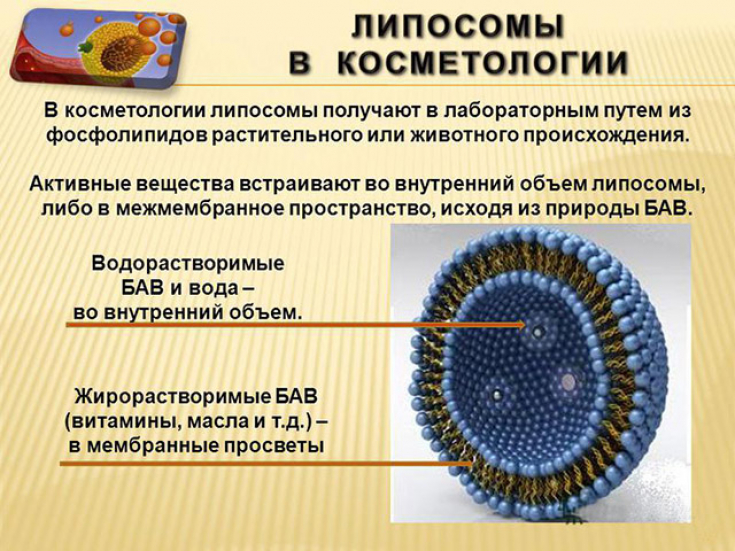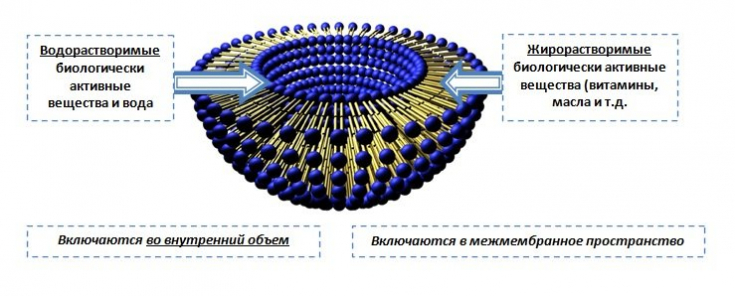Targeted delivery of substances in cosmetology? Already possible thanks to the use of nanotechnology in medicine! At the moment, the main discoveries in this area are liposomes, which can completely change approaches to treatment and conquer the entire pharmacological market of cosmetic preparations.
As part of nourishing and regenerating cosmetic creams, liposomes are effective as delivery systems for biologically active substances (BAS) - vitamins, microelements, hormones, plant components, etc.
Find out in our article on estet-portal.com the areas of application of liposomes and their mechanism of action.
Liposomes – nanotechnologies in medicine
Penetrating into the skin, the vesicles carry and increase the concentration of the active ingredient in the intercellular space and directly in the cells. Liposomes increase the solubility and delivery of substances that are poorly soluble in water and fat systems, reduce the irritating effect of many ingredients of the drug.
Follow us on Instagram!
In addition, the main components of liposomes (phospholipids, cholesterol, ceramides) are themselves important nutritional and regenerating components of cosmetic products, since they are involved in the construction of the cell membrane, redox processes in the skin.
The most abundant phospholipid in cosmetic liposomes − lecithin (phosphatidylcholine). Compared to other lipids, lecithin has a high level of stability and easily forms stable vesicles, is a natural antioxidant, and increases the plasticity of membrane cells. Phospholipid deficiency causes lethargy and exhaustion of the skin, disruption of its functions.
The use of lecithin in the form of liposomes ensures its high bioavailability!
Liposome Applications
Liposomes are able to combine with keratin, creating a protective layer on the surface of the skin that prevents water loss; they deliver moisturizing substances (polyhydric alcohols, proteins, etc.) to the appropriate areas of the skin, therefore they are effective ingredients in moisturizing cosmetics.
Liposomes are used in emulsion and hydrophilic cosmetic creams. Preference is given to the hydrophilic (gel) basis of the drug, since the structure of liposomes is unstable and can be destroyed under the influence of surface-active substances (surfactants) and lipids of emulsion systems.
The best sun protection: how to hide from UV radiation

As polymer matrix structures, standardized gelling agents are used: polyvinyl alcohols, cellulose derivatives, carbomer, natural polymers of chitosan, collagen, starch, and the like. Depending on the concentration and type of macromolecular compounds, liquid, semi-liquid, thick creamy masses are obtained.
Retinoids in cosmetology: modern discoveries of drug action
The gel base does not interfere with the gas exchange of the skin, is quickly absorbed, easily mixed with water, while maintaining the physico-chemical and physiological properties of the active ingredients. Active liposomal microparticles are distributed evenly and isolated from each other in the gel structure, are easily fixed and distributed on the surface of the skin or mucous membrane, quickly penetrate into the deep layers.
The combination of phospholipid vesicles and gel base is the optimal form of combining hydrophilic and fat-soluble components without the use of synthetic surfactants. These liposomal creams are the most effective treatment for oily skin sensitive to lipids.
One of the main problems associated with liposomal preparations is their instability during long-term storage.
Liposomes in an aqueous medium during storage undergo hydrolysis, aggregation, possibly peroxidation of phospholipids, release of the drug substance into the external environment, and the like. Together with liposomal suspension or emulsions, which are introduced into an inert carrier base, methods have been developed for obtaining dry powder preparations based on the so-called proliposomal technology.

Proliposomes are substances that, when interacting with water, spontaneously form vesicles. An additional advantage of the use of proliposomes in cosmetics is the possibility for the cosmetologist to independently select and include the necessary BARs in the composition of the liposomal preparation.
Other representatives of nanotechnologies in medicine
Among the new drug carriers and representatives of nanotechnologies in medicine, aquasomes should be singled out separately - a class of solid carriers consisting of a core, shell and drugs. The surface of the ceramic core is non-covalently modified with carbohydrates that absorb the therapeutic agent. The nucleus provides structural stability to this entity.
How to deal with complications of filler injections
The use of aquasomes is an effective way to use nanotechnology in cosmetology and deliver therapeutic agents of the protein and peptide classes, as they are able to overcome some of the problems inherent in these molecules, in particular, the choice of the necessary delivery route, physical and chemical instability, poor bioavailability and significant side effects. Surface modification with carbohydrates provides a smooth molecular stabilizing film that adsorbs therapeutic proteins with minimal structural denaturation. Thus, these particles provide protection to adsorbed drugs against the denaturing effects of external pH and temperature, since neither volume nor porosity is affected by these factors.
As we can see, the scope of these drugs is quite extensive, which in the future may serve as a widespread use of nanotechnology representatives in medicine.
Secrets of Successful Lower Eyelid Correction with HA Fillers








Add a comment